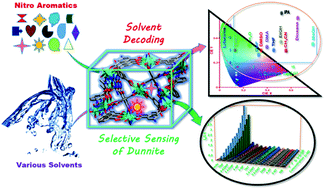A highly emissive fluorescent Zn-MOF: molecular decoding strategies for solvents and trace detection of dunnite in water†
Abstract
The strategic exploration of a highly emissive methoxy and amine-functionalized fluorescent three-dimensional MOF, {[Zn2(MTAIA)(DMF)2(H2O)]·H2O}n (1), based on a new custom-designed tetracarboxylate (H4MTAIA) ligand, is demonstrated for (i) decoding of solvents based on solvent polarity parameters and an unprecedented dual readout (lifetime and quantum yield) identification scheme and (ii) ultrafast detection of highly explosive dunnite, which was used during World War I, with high selectivity in water at the ppb level for the first time. This is a rare example of such a dual functional chemosensor.



 Please wait while we load your content...
Please wait while we load your content...